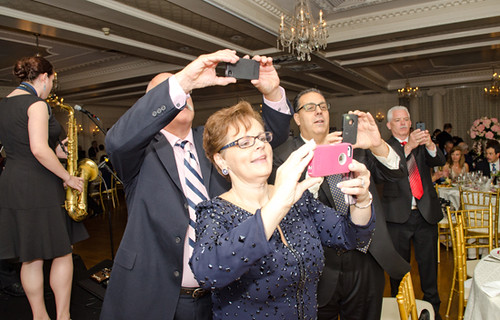
In the age of the “selfie,” smartphone cameras have turned novice photographers into amateur photojournalists.
With the latest video and photography technology now available on most cell phones, all the tools you need to capture amazing moments are right in the palm of your hand. It’s a fast, inexpensive way to document the moments you want to share over social media networks, like Instagram, Facebook, and Twitter and use in your marketing materials.
Whether you have a professional event photographer or not, smartphones can create interesting and organic images that otherwise might never be seen. At your next event rely on your smartphone’s camera to snap the photos and capture video that will connect emotionally with your donors by employing professional techniques photographers rely on to make their photos stand out.
Composition Counts
The goal of photographing an event is to shoot attention-grabbing images. Taking a variety of shots with dynamic composition is the first step to achieving this goal.
Frame Your Shot—Use the surrounding environment to put an interesting frame around the subject of your photo. Experiment with different angles or look for well-placed staging elements, like a window, to create the border—and remember the the Rule of Thirds.
Consider Your Lines—Lead the viewer’s eye straight to the subject by strategically placing them where the venue’s architecture will act as a runway to the subject of your photo.
Repositioning the Group Photo—The classic group photo places the tallest in the middle and goes down from there. For a new look try placing your tallest subjects at each end and your shortest person in the middle to create a new line for the viewer.
Orientation—Aim to shoot for your desired use. Landscape orientation will typically translate well for web and print layouts. Portrait is great for social media and vertical video typically means your viewer won’t have to rotate their phone to get the best view. Different phones have different ways of orienting the image after it’s taken so you may want to brush up on your manual before the event.
Know Your Settings and Surroundings
The settings on your camera are the tools that turn a good photo into an amazing one. Consider light, speed, and distance before pressing that button.
The Nature of Light—Lighting is so important in photography, but the main point is to be aware of the direction of your light source. Have your subject face the light to keep them out of the shadows.
To Zoom, or Not to Zoom—Have fun with the zoom lens feature on your camera. Zoom in to enhance the intimacy, or out to provide a general sense of space.
Slow Motion and Time-Lapse Settings—Most cell phone cameras now offer fun photo-taking options, which can add another layer to your video recordings. Play around during games with slow-motion speeds, or get a sweeping view of the venue using the panoramic setting.
Editing Tools
Easy-to-use editing tools have made your smartphone not only a camera but a darkroom as well, but be careful or your final result will lose the authenticity you meant to capture.
Cropping—Pare down your image to eliminate anything that distracts from the subject you want to capture most.
Fun With Filters—There are a number of filters that can change the image in interesting ways, but be careful not to stray from your goal of capturing the spirit of the event.
Smartphone cameras and their editing tools can create a large and varied archive of photos and video you can share over social media or use in next year’s marketing. With a little practice you’ll quickly become the photojournalist of your next event!
Shooting Video
Most smartphone cameras also have the ability to take video, which is a great way to reveal the most exciting moments of your program.
- Capture “winning” moments during games and raffles.
- Consider setting up a tripod during a keynote address.
- Invite your guests to get in on the fun! Ask one question of several people then combine the clips for a fun video to post on social media.
Greater Giving Tip:
Modern images carry embedded rotation information in them that Greater Giving will always follow. Number one cause of package images showing up rotated – that’s the way they were taken.
We recommend that any pictures you take to be used in package descriptions should be:
- Well lit – most phone cameras are very grainy in low light
- Simple background – the only subject in front of the camera should be your item to be auctioned.
- Taken in landscape (wide) mode – both the Online Bidding interface and the auction catalog are optimized for images that are wider than they are tall.
Five Photos to Take at Your Next Event
- The “story shot” could be the empty venue prior to your event or a nicely staged photo during your program.
- A candid photo depicts the exciting action at your event. Use the “burst” setting to give yourself choices during the editing process.
- Group shots bring the stars of the event into focus. Take a few to make sure you’ve got all eyes focused on the camera.
- A Close-up is the best approach to prompt an emotional connection between the subject of your photo with its viewer, but ask for permission first.
- Wide shots bring the whole event into focus. Experiment with your phones panoramic setting, but always take a landscape photo.
Uploading Your Photos or Video
We think about our phones as always clearly being in portrait (tall) or landscape (wide) mode, but there are times when we contort ourselves to take photos and the camera can seem as if it’s in landscape, but it actually isn’t. Make sure you look at the picture before upload and if it’s not in the expected orientation, fix it.
How to fix this:
- iOS: http://osxdaily.com/2012/05/01/rotate-photos-iphone-ipad/
- Android: http://informit.com/articles/article.aspx?p=2305173&seqNum=2 (under “edit pictures”)
- Windows (8+): http://tech-recipes.com/rx/56624/how-to-rotate-crop-photos-in-windows-10/
- Mac OS: http://osxdaily.com/2009/12/04/rotate-multiple-pictures-easily-in-mac-os-x-with-preview/


I am so grateful for this article. It goes 360 degrees around the entire subject!
That is great to hear. We plan on providing more helpful articles in the future. Feel free to reach out with suggestions on any topics you would like to see covered. Thank for reading!